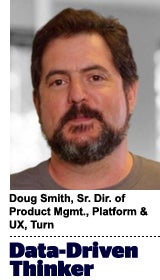 “Data-Driven Thinking” is written by members of the media community and contains fresh ideas on the digital revolution in media.
“Data-Driven Thinking” is written by members of the media community and contains fresh ideas on the digital revolution in media.
Today’s column is written by Doug Smith, senior director of product management, platform and user experience, at Turn.
With all that’s been written about AI in ad tech, it’s time to check in on the non-artificial intelligence side of the story – also known as you and me.
A colleague recently wrote about how AI in ad tech presents its own unique set of challenges. Applying deep-learning methods to computational advertising problems is difficult, he said, and at a minimum, resulting improvements from deep-learning methods aren’t significant.
That’s where you and I come in. Without the human element, the wonderful sweet jazz music of marketing just can’t happen.
Machines can make light-speed decisions from light-speed data inputs, but those decisions are driven by rules, and the rules are created by human-derived insights into consumer behavior. Humans are the I/O devices that understand what it means to improvise, anticipate and take risks. Sometimes, as seen in some of the most successful marketing campaigns, risk is required for great reward.
Remember the Old Spice brand resuscitation of 2010? The risk taken by the brand made it memorable, for better or for worse. Most feel it was for the better, and sales supported that claim.
The brand revival was orchestrated through a carefully planned campaign across national TV, with small audiences engaging in online video and a marquee example of social media brand sentiment feedback loops. No AI system in ad tech today could have composed that symphony and capitalized quickly enough on the trend. Perhaps an AI system could have kept momentum going by finding new pockets of interest and new ways of extending the campaign to even more potential consumers.
As for the human-centric quality of anticipation, a campaign optimization manager once gave me some telling feedback about how the user experience with DSP software could improve to enable anticipation: “Sometimes we know more than the system.”
For example, if a holiday weekend is approaching, including a weekday usually correlated with low performance, a CPG brand may want to take advantage to increase its media spend and thereby reach more consumers with a high likelihood of purchase. Only human input could anticipate the holiday weekend and the need to spend more on media, helping the machine make fast decisions.
One of the greatest of all human attributes is the ability to improvise. As Miles Davis once quipped, “I’ll play it first and tell you what it is later.” The marketer’s ability to react, in real time, to consumer sentiment, trending topics and conversations the consumer has started with the brand unveils the real promise behind the decisioning power of programmatic media.
The machine’s ability to give us the real-time trending data helps us to make on-the-spot, impactful decisions. For example, it was only a few years ago when Uber was able to strike brand gold by improvising a campaign in Boston during a bus strike.
Improvisation requires skill, practice and the ability to stray from the pattern just so far as to stretch, but not break, the connection with the audience. In the world of programmatic advertising, there’s a lot of discussion about “man vs. machine.” Can the machine make better decisions and drive performance more than the human? Can AI systems beat their human counterparts in architecting the perfect media sequence and frequency for a variety of audiences? Maybe, maybe not.
For now, I prefer to look at this as a “man-plus-machine” model. Each intelligent system augments the other. The machine can greatly simplify the management of campaigns and reporting on media spend, and it can automate decisions much faster and derive data to be analyzed. The human builds the insights on top of the data and creates the rule set and playing field for the machines to make decisions within and learn.
The human brings the superior qualities of calculated risk, anticipation and improvisation to the table. Then machines and algorithms can help make the resulting decisions take off, grow and let you play all that wild marketing jazz.
Follow Turn (@TurnPlatform) and AdExchanger (@adexchanger).













